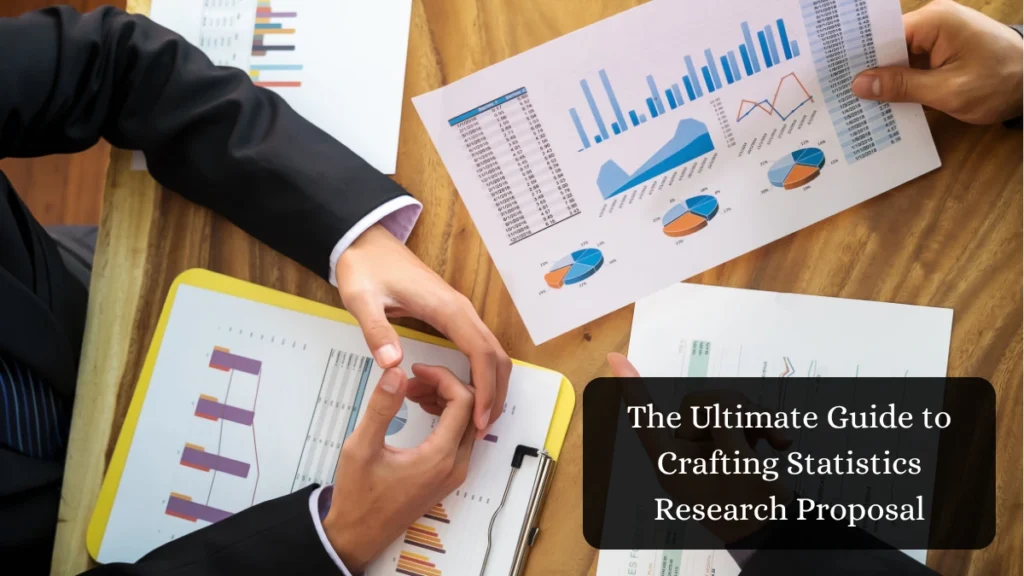The journey through advanced academia, whether a Master’s thesis or a Ph.D. dissertation, begins not with the collection of data, but with a meticulously crafted research proposal. For statisticians, this document is far more than a formality; it is the ultimate blueprint that demonstrates your intellectual rigor, subject matter mastery, and, crucially, your ability to conduct a feasible, sound, and impactful study.
A winning statistics research proposal acts as your professional charter. It secures crucial approval from supervisors, ethical review boards, and funding committees. If you are grappling with how to write a research proposal in statistics, understand this: your proposal must not merely outline a topic, but present a flawless, integrated argument that your proposed investigation is necessary, original, and, above all, statistically viable.
This comprehensive guide is designed to empower you, breaking down the complex process into manageable, actionable phases, ensuring your statistics research proposal achieves academic triumph.
The Core Distinction: General vs. Statistics Research Proposals
Table of Contents
While every proposal shares fundamental sections (Introduction, Literature Review, Methodology), the statistical proposal demands absolute precision in the methodology section. Unlike qualitative or general quantitative studies, your document must:
- Specify Hypotheses with Mathematical Clarity: Clearly articulate the null (H0) and alternative (Ha) statistical hypothesis.
- Justify Methodological Choices: Explain why a particular statistical model (e.g., ARIMA, Logistic Regression, Mixed-Effects Modeling) is the most appropriate tool for your research question.
- Demonstrate Power and Precision: Include a formal sample size calculation and power analysis, a non-negotiable part of a truly successful research proposal.
Phase 1: Building a Rock-Solid Foundation (Conceptualization & Review)
The initial phase dictates the success of your entire project. Rushing this stage often leads to fundamental flaws later on.
Pinpointing Your Compelling Research Question
A great statistical project starts with a testable question, not just a broad area of interest.
From Topic to Testable Hypothesis
- Identify the Gap: What is currently unknown or debated in the literature? For instance, “Does a specific new intervention X affect outcome Y?”
- Define Variables: Clearly establish your dependent, independent, and potential confounding variables. Specify their measurement scales (nominal, ordinal, interval, ratio). This classification immediately informs the appropriate statistical methods in research you will use later.
- Formulate the Statistical Hypothesis: Translate your research question into formal, quantifiable terms.
| Research Question Example | Null Hypothesis (H0) | Alternative Hypothesis (Ha) |
| Does the new teaching method (A) improve test scores more than the old method (B)? | μA=μB (There is no difference in mean test scores.) | μA>μB (Method A leads to higher mean scores.) |
The Strategic Literature Review: An Argument, Not a Summary
Your literature review must do more than list previous studies; it must build a persuasive argument for your proposed work. It demonstrates your fluency with existing research methodology statistics.
- Critique and Synthesis: Discuss the statistical models used by others. Did they use ANOVA when a non-parametric test was required? Did they address multicollinearity in their regression?
- Highlight the Methodology Gap: Conclude the review by clearly stating where the existing literature falls short, justifying your unique statistical approach. For example, “Prior studies utilized simple OLS regression; this statistics research proposal will pioneer the use of a hierarchical linear model to account for the nested nature of the data, providing a more robust inference.”
Phase 2: The Core Components of an Exceptional Proposal Structure
Every component of a research proposal must be perfectly aligned with the others. The flow from the Introduction to the Methodology must be seamless and logical.
Section 1: The Introduction and Significance (The Why)
This section is your opportunity to grab the reader’s attention and establish the importance of your work.
- Problem Statement: A clear, concise statement of the problem your research addresses. Why should anyone care?
- Aims and Objectives: Use action verbs (e.g., ‘to investigate’, ‘to model’, ‘to test’). For example, “The primary objective is to test the statistical hypothesis that the probability of customer churn is significantly predicted by the interaction of age and time on site using a quantitative research proposal approach.”
- Significance: Detail the theoretical and practical implications. How will your findings contribute to statistical theory or real-world policy?
Section 2: Methodology and Data Analysis Plan (The Statistical Masterpiece)
This is the most crucial section for a statistics research proposal and requires the deepest dive. It must contain sufficient detail for another competent statistician to replicate your study.
Study Design and Sampling Strategy
- Design Justification: Clearly specify the study type (e.g., experimental, quasi-experimental, observational, simulation). Justify why this design is the most efficient and least biased way to answer your research question.
- Sampling: Detail your population, sample frame, and sampling technique (e.g., simple random, stratified, cluster). Explain how this selection minimizes selection bias and maximizes generalizability.
The Statistical Precision: Sample Size and Power Analysis
This is where the proposal demonstrates feasibility and rigor.
The data analysis plan must include the basis for your sample size calculation (n). You must state:
- The desired level of significance (α, typically 0.05).
- The desired statistical power (1−β, typically 0.80).
- The effect size (d or η2) you aim to detect, based on pilot data or prior literature.
Example:
Sample size was calculated using G*Power software based on detecting a moderate effect size (d=0.5) with 80% power and a 5% significance level. This yields a minimum requirement of n=64 per group for a two-sample t-test.
The Statistical Methods in Research: Detailed Analysis Plan
This subsection is the heart of how to write a research proposal in statistics.
- Descriptive Statistics: List the summary measures (Mean, SD, Median, IQR) and graphical displays (Histograms, Box Plots) you will use for initial data exploration.
- Inferential Statistics: Explicitly name the primary statistical test(s) to be used to test your H0.
- Example (Time-Series Data): “Primary analysis will utilize an Autoregressive Integrated Moving Average (ARIMA) model to forecast the trend, with the Ljung-Box Q-test used to check for autocorrelation in the residuals.”
- Example (Categorical Data): “A Binary Logistic Regression model will be employed to estimate the odds of the binary outcome, controlling for five pre-specified covariates. Model fit will be assessed using the Hosmer–Lemeshow test.”
- Assumptions: For each method, list the key assumptions (e.g., normality, homoscedasticity, independence) and the diagnostic tests you will perform (e.g., Shapiro-Wilk for normality, Levene’s test for equality of variances).
- Software: Specify the statistical software package (e.g., R, Python with NumPy/SciPy, SPSS) you will use.
Phase 3: Feasibility, Ethics, and Anticipated Outcomes (The Logistics)
A strong proposal addresses not only the intellectual challenge but also the practical realities of the project. This is crucial for demonstrating that your quantitative research proposal is feasible within your timeline and resources.
Project Timeline (Gantt Chart Recommendation)
A detailed, chapter-by-chapter or phase-by-phase timeline (often presented as a Gantt chart) proves you have a realistic execution strategy.
| Phase | Duration | Key Deliverables (Statistical) |
| Literature Review & Proposal Finalization | 2 Months | Finalized Statistical Hypothesis and Data Management Protocol. |
| Data Collection & Cleaning | 3 Months | Complete, cleaned dataset; Preliminary Descriptive Analysis Report. |
| Data Analysis & Modeling | 4 Months | Finalized Data Analysis Plan report; Statistical Model Output. |
| Thesis/Dissertation Writing | 3 Months | Completed Draft. |
Ethical Considerations and Data Management
In statistical research, ethics primarily revolves around data.
- Data Privacy: Detail how you will anonymize or de-identify sensitive data.
- Storage and Security: Describe the secure environment where your raw data and analytical scripts will be stored, demonstrating compliance with data protection regulations.
Limitations and Delimitations: Proving Statistical Awareness
A hallmark of an exceptional statistics research proposal is the honest discussion of limitations.
- Limitations: Acknowledge potential threats to validity (e.g., sample attrition, non-response bias, limitations of the chosen statistical methods). Explain your strategies to mitigate these (e.g., multiple imputation for missing data).
- Delimitations: Clearly define the boundaries of your study (what you won’t study), such as restricting the study population or excluding certain analytical techniques to maintain focus.
The Flawless Finish: Final Review for a Successful Proposal Submission
Before submitting your statistics research proposal, conduct a final, rigorous review.
- Consistency Check: Does the title accurately reflect the research question? Do the objectives directly align with the statistical hypothesis? Does the data analysis plan logically follow the methodology?
- Clarity and Flow: Is the proposal easy to read? Have you avoided overly dense paragraphs of text? Use bullet points and tables (like the ones above) to enhance readability and organization.
- Proofread for Technical Accuracy: A single misplaced statistical term or formula error can undermine your credibility. Ensure that the degrees of freedom, p-values, and effect sizes are referenced correctly in your discussion of prior work.
Conclusion: Launching Your Exceptional Research Journey to Mastery!
Mastering how to write a research proposal in statistics is your first major step towards professional and academic mastery. It forces you to think critically, methodologically, and, most importantly, statistically, before you even engage with the data. By meticulously following this comprehensive guide—from formulating a clear statistical hypothesis to detailing your data analysis plan—you are not just creating a document; you are building the foundation for a truly impactful, rigorous, and ultimately successful research proposal.
Also Read: Incredible and Inspiring Real-Life Applications of Inferential Statistics
Do I need to collect my data before submitting?
Generally, no. You need a detailed Data Analysis Plan and proof of feasibility (e.g., access to a pre-existing dataset or a clear sampling strategy and budget/timeline for collection).
What is the most critical section for a statistics proposal?
The Methodology and Data Analysis Plan. Reviewers need to see a detailed, justified plan outlining your statistical models, assumptions, and power calculation. Vague statements about using “appropriate statistics” will lead to rejection.
Where can I find examples of strong methodology sections?
Many universities and research institutions provide publicly available, successful proposals. For a detailed guide on how to structure and justify your approach, you can refer to authoritative academic resources like this guide on writing a research methodology section.


